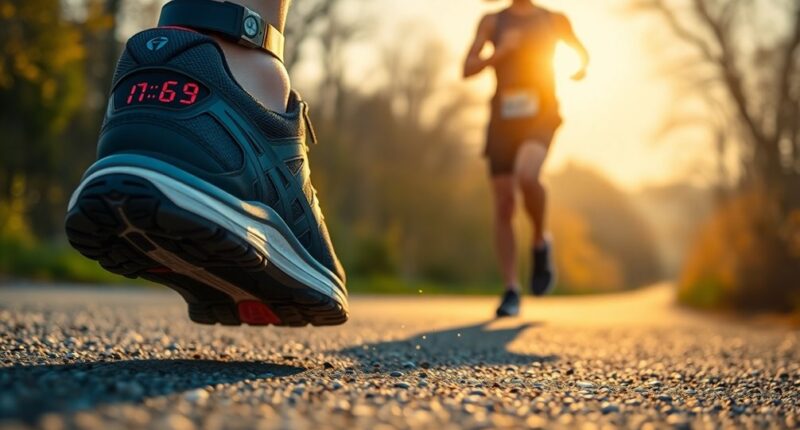Running a mile typically burns between 100 to 170 calories. This varies based on your body weight, with a 200-pound person burning about 142 calories, while a 180-pound person burns roughly 170. Your running pace also plays a role but doesn't greatly affect the calories burned per mile. Factors like terrain and individual differences matter too. Curious about the benefits of running and how to start a routine? There's more to discover!
Key Takeaways
- On average, running burns about 112.5 calories per mile, varying by individual factors like body weight and fitness level.
- A 200-pound person burns approximately 142 calories per mile, while a 180-pound runner burns around 170 calories.
- Running generally burns more calories than walking, with about 112.5 calories burned per mile compared to 88.9 calories for walking.
- The afterburn effect can increase total caloric burn by 15-25% after intense running sessions, lasting up to 24 hours.
- Environmental conditions and running pace have minimal impact on caloric burn per mile, focusing instead on overall distance covered.
Understanding Caloric Burn Basics

When you run a mile, it's essential to understand how your body burns calories, especially since this can vary greatly based on individual factors.
On average, you burn about 100 calories per mile of running, but this estimate changes with your body weight. For instance, if you weigh 200 pounds, you could burn around 142 calories in that mile.
Notably, running speed doesn't greatly impact the caloric burn per mile; the energy used remains fairly consistent regardless of pace. You burn approximately 0.71 calories per pound of body weight for each mile run.
Keep in mind that devices tracking your caloric burn can be inaccurate, often by about 30%, so it's wise to take these factors into account when estimating your caloric expenditure.
Factors Affecting Calories Burned
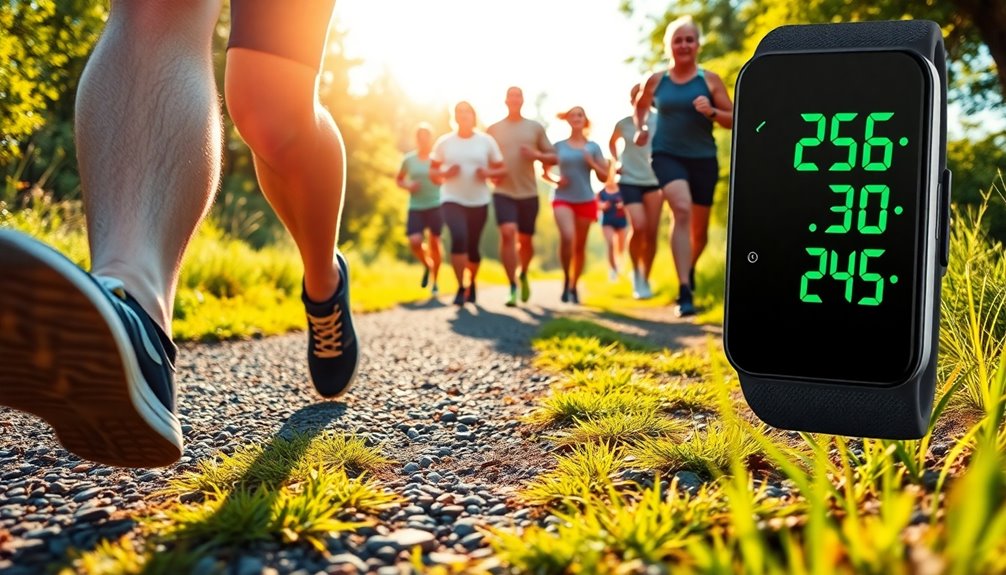
Several factors influence how many calories you burn while running a mile, making it vital to contemplate your unique circumstances.
Your body weight greatly affects calories burned; for instance, a 180-pound person burns about 17 calories per minute, while a 120-pound person burns around 11.4 calories.
Additionally, your running pace plays a key role; faster speeds generally lead to higher caloric burn due to increased effort.
Environmental factors, like running on hills or uneven surfaces, can also elevate your caloric burn compared to flat terrain.
Don't forget gender differences; males typically burn more calories than females because of higher muscle mass and metabolic rates.
Understanding these aspects can help you better estimate your calorie expenditure while running.
Running Pace and Its Impact on Caloric Expenditure

Your running pace plays a key role in how many calories you burn, with faster speeds generally leading to higher expenditure.
However, the difference in calories burned per mile isn't as drastic as you might think, since most of your energy comes from aerobic sources regardless of pace.
You'll find that while speeding up can increase your total burn over time, the calories burned per mile remain fairly consistent.
Pace and Caloric Burn
Running pace plays an essential role in determining how many calories you burn during a run, as faster speeds generally lead to greater energy expenditure.
For instance, a 120-pound person burns about 11.4 calories per minute at a 10-minute mile pace, while a 180-pound individual burns around 17 calories per minute.
When you run at a quicker pace, you may burn an additional 0.71 calories per pound of bodyweight per mile.
Consistently maintaining your running speed lets you estimate your calorie burn more accurately.
Even though average caloric burn hovers around 100 calories per mile, your weight and pace greatly influence the total calories burned, making pace a vital factor in your overall caloric expenditure.
Running Speed Effect
While many believe that running faster considerably boosts calorie burn, the reality is a bit more nuanced. Your caloric burn largely depends on the distance rather than just speed.
Here's how running pace impacts calories burned:
- At an average of 0.71 calories per pound, a 180-pound runner burns about 170 calories at a 10-minute mile pace.
- Running faster might allow you to cover more distance in less time, increasing total caloric burn.
- The average caloric burn for running one mile is around 112.5 calories.
- Ultimately, the primary factor for energy expenditure remains the distance covered, not just your pace.
Consistency in Exertion
Understanding the impact of running pace on caloric expenditure reveals that maintaining a consistent exertion level can lead to predictable energy burn.
While you might think faster speeds burn considerably more calories, the truth is that the total calories burned per mile remains relatively stable, regardless of pace.
For example, a 120-pound person burns about 114 calories running a mile at a 10-minute pace, while a heavier runner burns around 170 calories.
This consistency in exertion allows you to estimate your energy expenditure more easily, as you'll typically burn approximately 0.71 calories per pound per mile.
Calories Burned Running vs. Walking
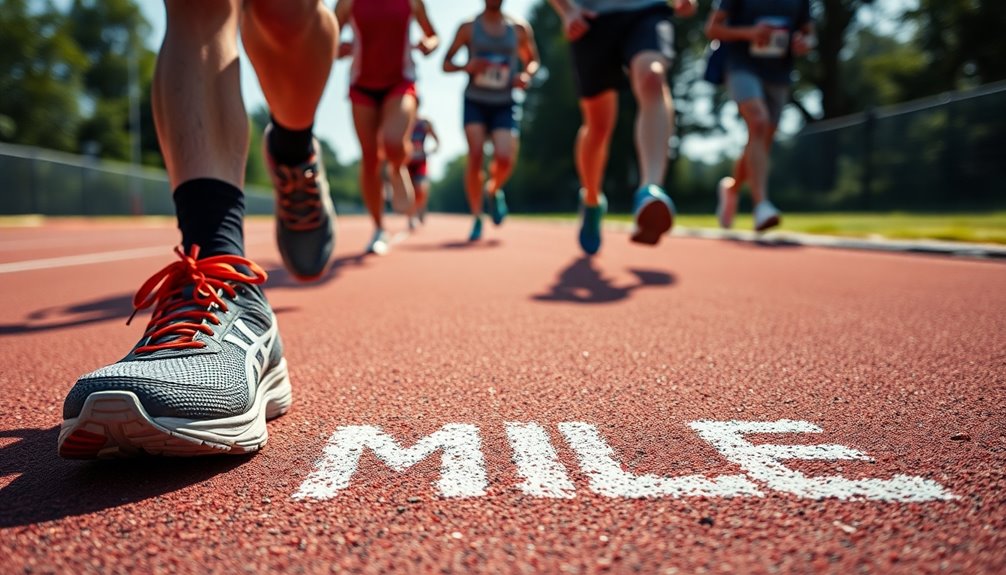
When you compare the calories burned from running versus walking, you'll find that running typically burns more calories per mile.
Here's a breakdown of the numbers:
- Calories burned running: About 112.5 calories per mile.
- Calories when walking: Approximately 88.9 calories per mile.
- Men's burn rate: Around 105 calories per mile running vs. 52 calories walking.
- Women's burn rate: Approximately 91 calories running vs. 43 calories walking.
The difference in energy expenditure is due to the increased vertical movement in running, which requires more effort.
Although walking can sometimes compete with slow running, if you want to burn more calories, running is usually the way to go in the walking vs running debate.
The Afterburn Effect: Additional Calories Burned Post-Run

After your run, you might be surprised to learn that your body continues to burn calories at an elevated rate.
This afterburn effect can last up to 24 hours, depending on how intense your workout was.
If you push yourself with high-intensity running, you'll not only burn more during your run but also enjoy extra calorie burn during recovery.
Elevated Caloric Expenditure
While you may think the calorie burn from running stops once you cross the finish line, the afterburn effect proves otherwise. This phenomenon, also known as excess post-exercise oxygen consumption (EPOC), can boost your calorie burn by 15-25% for up to 24 hours after intense running sessions.
Here's how it works:
- Elevated heart rate keeps burning calories.
- Increased breathing rate contributes to energy expenditure.
- Higher intensity workouts enhance the afterburn effect.
- Individual factors like weight and fitness level influence total calories burned.
Incorporating interval training or high-intensity runs can maximize this effect, ensuring you continue to burn calories long after your run ends.
Duration of Afterburn Effect
The duration of the afterburn effect can vary considerably, but it typically lasts up to 24 hours after your run.
This phenomenon, also known as excess post-exercise oxygen consumption (EPOC), can lead to an increase in calories burned by 15-25% after a vigorous run.
After intense workouts, your body continues consuming oxygen at an elevated rate, resulting in additional calories being burned as it returns to its resting state.
Factors like workout intensity, duration, and individual fitness levels play significant roles in determining the afterburn effect.
Generally, you can expect to burn an extra 50-100 calories post-run, especially if you've pushed yourself with higher intensity exercises.
Embrace the afterburn to maximize your workout benefits!
Calculating Your Calories Burned While Running
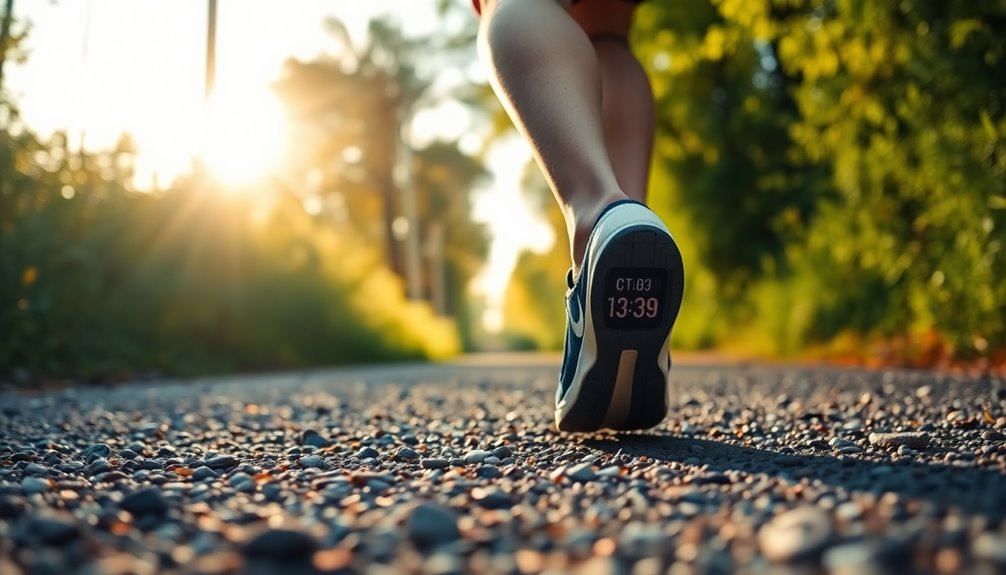
Understanding how to calculate calories burned while running can help you tailor your workouts for better results.
Here's a simple way to estimate your caloric expenditure:
- Know Your Body Weight: Your weight in pounds is essential.
- Use the Formula: Multiply your body weight by 0.71 to calculate calories burned per mile.
- Example Calculation: A 150-pound person running a mile burns about 106.5 calories (150 x 0.71).
- Consider Variability: The average caloric burn for running a mile is roughly 100 calories, but your individual factors, like running efficiency, can affect this.
Tech Tools for Tracking Caloric Expenditure
Advanced tech tools can make tracking caloric expenditure during your runs easier and more accurate than ever. Fitness trackers from brands like Fitbit and Garmin analyze your heart rate and activity data in real-time to provide insights into the calories burned.
Smartphone apps like Runkeeper, Strava, and MapMyRun utilize GPS to estimate caloric expenditure based on distance, speed, and your weight. While treadmill calorie calculators can give a rough estimate, they often overstate actual calories burned by about 30%.
To enhance accuracy, consider using heart rate monitoring devices that factor in your fitness level. Additionally, online calculators require input like your age, weight, gender, and heart rate to give personalized estimates, ensuring you have a clearer picture of your caloric expenditure.
Other Benefits of Running Beyond Calorie Burn

While tracking calories burned during your runs is helpful, the benefits of running extend far beyond just weight management. Running fosters a sense of accomplishment and boosts self-esteem as you progressively reach personal goals. Additionally, the mental health benefits of running are well-documented; engaging in this physical activity can reduce anxiety and depression while enhancing overall mood. The rhythmic nature of running often provides a meditative quality, allowing for clarity of thought and a release from daily stressors.
Here are some key advantages you'll experience:
- Cardiovascular Fitness: Running boosts heart and lung function, enhancing your overall endurance and stamina.
- Heart Health: This exercise improves blood circulation and lowers blood pressure, reducing your risk of heart disease.
- Mental Well-Being: The endorphins released during running can notably reduce anxiety and depression, making you feel great.
- Bone Strength: Regular running strengthens bones and muscles, decreasing the risk of osteoporosis and improving bone density.
Getting Started With a Running Routine
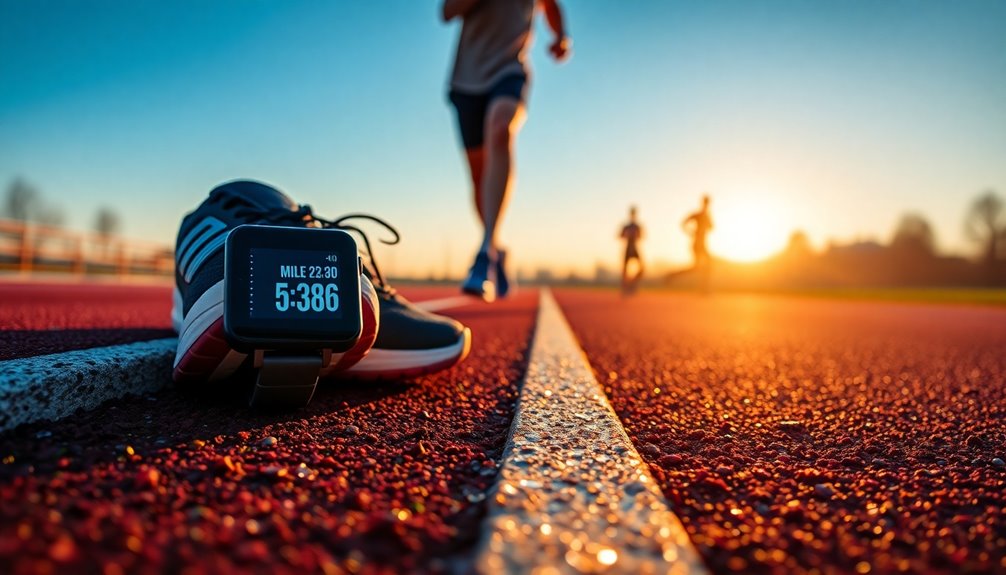
When you're starting a running routine, setting realistic goals is key to staying motivated.
Don't forget to choose proper footwear, too—good running shoes can make all the difference in your comfort and performance.
With the right mindset and gear, you'll be on your way to hitting the trails in no time.
Setting Realistic Goals
Setting realistic goals is essential for anyone looking to start a running routine, as it helps keep you motivated and on track.
To effectively set your goals, consider the following:
- Aim for at least three running sessions per week to build endurance.
- Increase your distance or pace by no more than 10% each week to prevent injury.
- Set specific goals, like running a mile without stopping or achieving a target pace.
- Use a fitness tracker to monitor your progress and learn how many calories are burned during each run.
Choosing Proper Footwear
Choosing the right footwear is essential for a successful running routine, as it can greatly impact your comfort and performance. Proper running footwear helps prevent injuries by providing the support and cushioning tailored to your running style and foot type.
Visit a specialty running store for a gait analysis to find quality shoes that match your biomechanics. Remember, running shoes should be replaced every 300 to 500 miles; worn-out shoes can lead to discomfort and hinder your energy expenditure.
Look for shoes with adequate arch support and a snug fit to prevent blisters. Also, consider the terrain: trail running shoes offer better grip for uneven surfaces, while road shoes are designed for smooth pavements, ensuring you maximize calories burned efficiently. Additionally, choosing footwear that accommodates your running style can further enhance your performance and reduce the risk of injury.
A Quick Review of Key Points
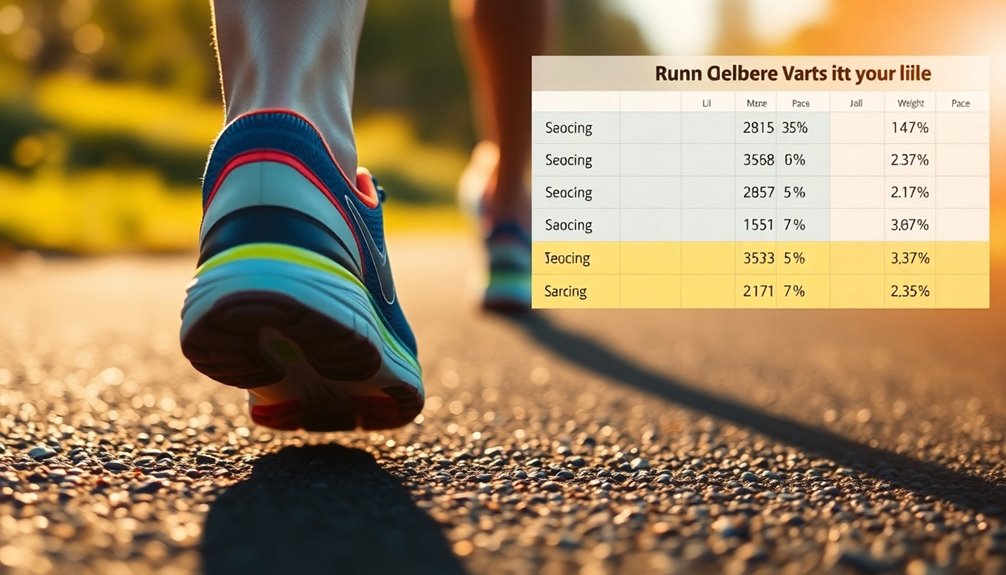
Running a mile typically burns around 100 calories, but this number can vary based on factors like your body weight and running efficiency.
Here's a quick breakdown to help you understand how energy expenditure works:
- A 120-pound person burns about 114 calories running a 10-minute mile.
- A 180-pound person burns around 170 calories for the same distance and pace.
- A 200-pound runner would burn approximately 142 calories per mile.
- Running tends to burn more calories than walking, with an average of 112.5 calories burned per mile running compared to 88.9 calories walking.
Frequently Asked Questions
Does Walking 1 Mile Burn the Same Calories as Running 1 Mile?
No, walking 1 mile doesn't burn the same calories as running 1 mile.
When you run, you engage more muscles and expend more energy due to the increased vertical movement, which leads to higher calorie burn.
On average, you'll burn more calories running compared to walking the same distance.
If you're looking to maximize your calorie burn, running is the more efficient choice.
However, both activities offer great health benefits!
What Is the Number of Miles One Runs and the Number of Calories Burned Have?
When you run miles, the calories burned depend on how far you go and your body weight.
Generally, you can estimate about 100 calories per mile, but it's not a one-size-fits-all. Your pace, terrain, and individual factors play significant roles.
If you weigh more, you'll burn more calories.
Using a fitness tracker can help you get a more accurate estimate based on your specific details, making your efforts more rewarding.
How to Calculate Calories Burned From Running?
Calculating calories burned from running is like finding treasure on a map. You start with your weight in pounds, multiply it by the distance you run in miles, and then multiply that by 0.71.
This gives you a rough estimate of calories burned. If you want a more personalized treasure hunt, consider using fitness trackers or online calculators that factor in your unique variables like heart rate and running pace.
How Much Running to Burn 1000 Calories?
To burn 1,000 calories, you need to take into account factors like your weight, running speed, and terrain.
If you weigh around 140 pounds, you might've to run about 7.5 miles at a 10-minute mile pace.
At 180 pounds, you'd only need to cover roughly 6 miles.
Running faster could help you reach that calorie burn in a shorter distance, so track your efforts with an app for more accurate insights.
Conclusion
To sum up, understanding how many calories you burn while running a mile can feel like unraveling a complex puzzle, but it's worth it! By considering factors like pace and body weight, you can tailor your runs for maximum burn. Remember, running isn't just about the calories; it's a powerhouse for boosting your mood and health. So lace up those shoes and hit the pavement—your body will thank you like it just won the lottery!
